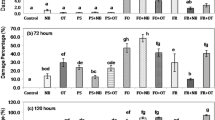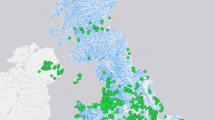Abstract
A retrospective analysis shows that invasive, alien, free-floating and emergent aquatic weeds in Europe are good targets for classical biological control, and that genus-specific chrysomelid and curculionid beetles offer the most potential. Ludwigia spp., Azolla filiculoides, Lemna minuta, Crassula helmsii and Hydrocotyle ranunculoides should be prioritised as targets. Fungal pathogens have been under-utilised as classical agents but, whilst they may have some potential against free-floating weeds, they appear to be poor candidates against submerged species, although the suitability of arthropod agents against these difficult targets still merits investigation. The use of indigenous pathogens as inundative agents (mycoherbicides) shows some promise.
Similar content being viewed by others
References
B. Blossey R. Casagrande L. Tewsksbury D. A. Landis R. N. Wiedenmann D. R. Ellis (2001) ArticleTitleNon-target feeding of leaf-beetles introduced to control purple loosestrife (Lythrum salicaria L.) Natural Areas Journal 21 368–377
G. R. Buckingham (1989) ArticleTitle Lemnaphila scotlandae (Diptera: Ephydridae) and three of its parasites discovered in Florida Florida Entomologist 72 219–221
Cilliers, C. J., 1999. Biological control of parrot’s feather, Myriophyllum aquaticum (Vell.) Verdc. (Haloragaceae), in South Africa. In Olckers T. & M. P. Hill (eds), Biological Control of Weeds in South Africa (1990–1998). African Entomology Memoir 1: 113–118
Cordo, H. A., C. J. DeLoach & R. Ferrer, 1982. The weevils Lixellus, Tanysphiroideus, and Cyrtobagous that feed on Hydrocotyle and Salvinia in Argentina. Coleopterists Bulletin 36: 279–286
M. J. Crawley (1989) ArticleTitleThe successes and failures of weed biocontrol using insects Biocontrol News and Information 10 213–223
R. P. Creed S. P. Sheldon (1995) ArticleTitleWeevils and watermilfoil: did a North American herbivore cause the decline of an exotic plant? Ecological Applications 5 1113–1221 Occurrence Handle10.2307/2269358
Evans, H. C. & R. H. Reeder, 2000. Fungi associated with Eichhornia crassipes (water hyacinth) in the upper Amazon basin and prospects for their use in biological control. In Biological and Integrated Control of Water Hyacinth, Eichhornia crassipes (2001). Proceedings of the Global Working Group for the Biological Control and Integrated Control of Water Hyacinth, Beijing, China. ACIAR Proceedings No. 102: 62–70
H. C. Evans M. P. Greaves A. K. Watson (2001) Fungal biocontrol agents of weeds T. M. Butt C. W. Jackson N. Magan (Eds) Fungi as Biocontrol Agents CABI Publishing Wallingford, UK 169–192
I. W. Forno M. H. Julien (2000) Success in biological control of aquatic weeds by arthropods G. Gurr S. Wratten (Eds) Biological Control: Measures of Success Kluwer Academic Publishers Amsterdam 159–187
A. Gassmann (1995) ArticleTitleEurope as a source of biological control agents of exotic invasive weeds: status and implications Bulletin de la société entomologique Suisse 68 313–322
M. S. Goettel A. E. Hajek J. P. Siegel H. C. Evans (2001) Safety of fungal biocontrol agents T. M. Butt C. W. Jackson N. Magan (Eds) Fungi as Biocontrol Agents CABI Publishing Wallingford, UK 347–375
P. Harris (1991) ArticleTitleClassical biocontrol of weeds: its definition, selection of effective agents, and administrative-political problems Canadian Entomologist 123 827–849 Occurrence Handle10.4039/Ent123827-4
J. L. Harvey D. R. Varley (1996) Evaluation of European pathogens for the control of Myriophyllum spicatum in the USA V. C. Moran J. H. Hoffman (Eds) Proceedings of the IXth International Symposium on Biological Control of Weeds University of Cape Town South Africa 177–182
Hill, M. P., 1999. Biological control of red water fern, Azolla filiculoides Lamarck (Pteridophyta: Azollaceae), in South Africa. In Olckers, T. & M. P. Hill (eds), Biological Control of Weeds in South Africa (1990–1998). African Entomology Memoir 1: 119–124
Hill, M. P. & C. J. Cilliers, 1999. A review of the arthropod natural enemies, and factors that influence their efficacy, in the biological control of water hyacinth, Eichhornia crassipes (Mart) Solms-Laubach (Pontederiaceae), in South Africa. In Olckers, T. & M. P. Hill (eds), Biological Control of Weeds in South Africa (1990–1998). African Entomology Memoir 1: 103–112
Janes, R. A., 1995. The biology and control of Azolla filiculoides and Lemna minuta. PhD Thesis, University of Liverpool, UK
Julien, M. H. 2001. Biological control of water hyacinth with arthropods: a review to 2000. In Julien, M. H., M. P. Hill, T. D. Center & Ding Jianqing (eds), Biological and integrated control of water hyacinth, Eichhornia crasssipes. Proceedings of the Second Meeting of the Global Working Group for the Biological and Integrated control of Water hyacinth, Beijing, China, 9–12 October 2000. ACIAR Proceedings 102: 8–20
Lawton, J. H., 1990. Biological control of plants: a review of generalisations, rules, and principles using insects as agents. In Bassett, C., L. J. Whitehouse & J. A. Zabkiewicz (eds), Alternatives to the chemical control of weeds. Proc. of an Int. Conf., Rotorua, New Zealand, July 1989. Ministry of Forestry, FRI Bulletin 155
J. Marohasy (1996) ArticleTitleHost shifts in biological weed control: real problems, semantic difficulties or poor science? International Journal of Pest Management 42 71–75 Occurrence Handle10.1080/09670879609371974
M. A. McGregor D. R. Bayne J. G. Steeger E. C. Webber E. Reutebuch (1996) ArticleTitleThe potential for biological control of water primrose (Ludwigia grandiflora) by the water primrose flea beetle (Lyathia ludoviciana) in the Southeastern United States Journal of Aquatic Plant Management 34 74–76
R. E. C. McFadyen (1998) ArticleTitleBiological control of weeds Annual Review of Entomology 43 369–393 Occurrence Handle15012395 Occurrence Handle1:CAS:528:DyaK1cXktleitQ%3D%3D Occurrence Handle10.1146/annurev.ento.43.1.369
Napompeth, B., 1990. Country Report: Thailand. Biological control of weeds in Thailand. Biotrop Special Publication 38: 23–36
R. M. Newman M. E. Borman S. W. Castro (1997) ArticleTitleDevelopmental performance of the weevil Euhrychiopsis lecontei on native and exotic watermilfoil host plants Journal of the North American Benthological Society 16 627–634 Occurrence Handle10.2307/1468149
R. W. Pemberton (2000) ArticleTitlePredictable risk to native plants in weed biological control Oecologia 125 489–494 Occurrence Handle10.1007/s004420000477
J. Shearer (1998) ArticleTitleBiological control of Hydrilla using an endemic fungal pathogen Journal of Aquatic Plant Management 36 54–56
Tutin, T. G., V. H. Heywood, N. A. Burges, D. H. Valentine, S. M. Walters & D. A. Webb (eds), 1964. Flora Europaea, I–V
U. Verma R. Charrudattan (1993) ArticleTitleHost range of Mycoleptodiscus terrestris, a microbial herbicide candidate for Eurasian watermilfoil, Myriophyllum spicatum Biological Control 3 271–280 Occurrence Handle10.1006/bcon.1993.1036
A. J. Wapshere (1974) ArticleTitleA strategy for evaluating the safety of organisms for biological weed control Annals of Applied Biology 77 201–211 Occurrence Handle10.1111/j.1744-7348.1974.tb06886.x
A. J. Wapshere (1985) ArticleTitleEffectiveness of biological control agents for weeds: present quandries Agriculture Ecosystems & Environment 13 261–280 Occurrence Handle10.1016/0167-8809(85)90015-5
Author information
Authors and Affiliations
Corresponding author
Rights and permissions
About this article
Cite this article
Gassmann, A., Cock, M.J.W., Shaw, R. et al. The potential for biological control of invasive alien aquatic weeds in Europe: a review. Hydrobiologia 570, 217–222 (2006). https://doi.org/10.1007/s10750-006-0182-4
Issue Date:
DOI: https://doi.org/10.1007/s10750-006-0182-4




